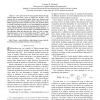Free Online Productivity Tools
i2Speak
i2Symbol
i2OCR
iTex2Img
iWeb2Print
iWeb2Shot
i2Type
iPdf2Split
iPdf2Merge
i2Bopomofo
i2Arabic
i2Style
i2Image
i2PDF
iLatex2Rtf
Sci2ools
85
Voted
ISCAS
2006
IEEE
2006
IEEE
A neural model for sonar-based navigation in obstacle fields
— The rapid control of sonar-guided vehicles through obstacle fields has been a goal of robotics for decades. How sensory data is represented strongly affects how obstacles and goal information can be combined to select a direction of travel. While typical approaches combine attractive and repulsive effects to directly determine steering, we are investigating an algorithm that evaluates multiple directions simultaneously followed by a winner-take-all (WTA) function which then guides steering. In this paper we describe a neuromorphic VLSI implementation of this algorithm using the inherent echo delay to create a rangedependent gain in a ‘race-to-first-spike’ neural WTA circuit. The chip was fabricated in a commercially-available 0.5µµµµm CMOS process and in this paper we present preliminary test results.
Related Content
| Added | 12 Jun 2010 |
| Updated | 12 Jun 2010 |
| Type | Conference |
| Year | 2006 |
| Where | ISCAS |
| Authors | Timothy K. Horiuchi |
Comments (0)

